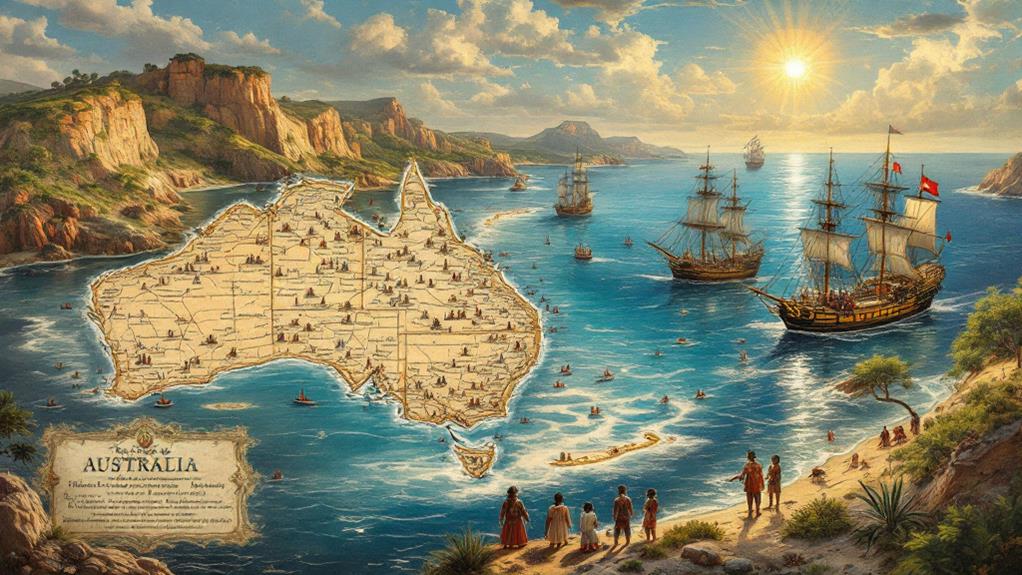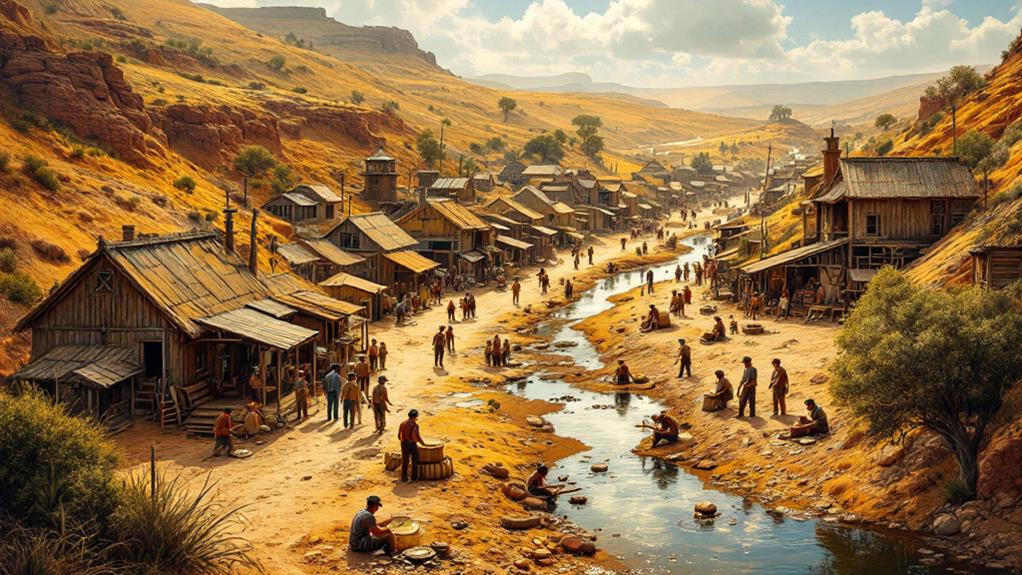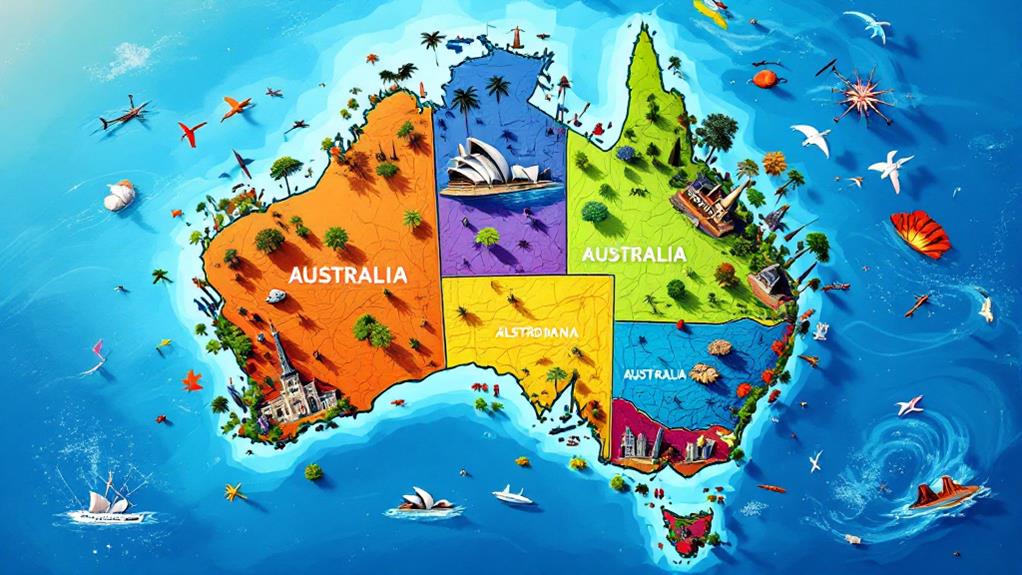Who Discovered Australia? A Timeline of Exploration and Colonization

You're exploring a rich history that starts with Indigenous Australians arriving over 65,000 years ago. They thrived with sustainable practices long before Europeans set foot on the continent. The Dutch began exploring in 1606, with Willem Janszoon at Cape York Peninsula, followed by Dirk Hartog and Abel Tasman. Captain James Cook charted the eastern coast in 1770, paving the way for British colonization in 1788. The arrival of the Initial Fleet marked the start of a penal colony in New South Wales. Each phase of exploration and settlement left an indelible mark that shapes Australia today, and there's more to uncover.
Indigenous Beginnings
Indigenous Australians have shaped the continent for tens of thousands of years, with their arrival dating back between 50,000 to 65,000 years ago. These Indigenous peoples created the world's oldest continuous cultures, profoundly influencing the land we recognize today. When you investigate this rich history, you'll find that approximately 300,000 to one million Aboriginal Australians lived in diverse societies, organized into around 600 tribes, each with unique customs and practices.
Their deep spiritual connection to the land is central to Aboriginal culture, with The Dreaming forming the foundation of their beliefs. The Dreaming isn't just mythology; it's a complex tapestry of laws, societal structures, and spiritual guidance that have sustained these cultures for millennia. This spiritual connection fostered sustainable management practices, such as fire-stick farming, which shaped Australia's landscapes and enabled effective hunting and gathering.
The Madjedbebe rock shelter, the oldest known human occupation site in Australia, dating back around 65,000 years, stands as a symbol of Indigenous Australians' long-standing presence. Their sustainable practices guaranteed the land's health and abundance, allowing these tribes to thrive for generations. This profound legacy remains an essential part of Australia's story.
Early European Contacts
As you examine the rich tapestry of Australia's history, the timeframe of early European contacts emerges as a vital chapter. This period began in 1606 when Dutch navigator Willem Janszoon landed at Cape York Peninsula, marking the initial recorded European contact. His investigation led to the charting of approximately 300 kilometers of Australia's northern coastline. These preliminary encounters laid the groundwork for further expeditions by Dutch explorers who named the continent New Holland.
Here are some key highlights of early European contacts:
- Dirk Hartog's Visit: In 1616, another significant event occurred when Dutch explorer Dirk Hartog landed at Shark Bay, reinforcing the early European presence on Australian shores.
- Abel Tasman's Contribution: In 1642, Abel Tasman, a prominent Dutch explorer, sighted Tasmania, adding to the growing European knowledge of the area.
- William Dampier's Exploration: Later, British explorer William Dampier reached the north-west coast in 1688 and 1699, further expanding European awareness.
Interest from the British surged when Captain James Cook charted the east coast in 1770. His investigation led to claiming the land for Britain and eventually spurred the initial British settlement, setting a course for future colonization.
Dutch Exploration

When you investigate the period of Dutch exploration in Australia, you'll reveal a fascinating sequence of voyages that reshaped European understanding of the continent. It all commenced in 1606 when Willem Janszoon, a Dutch navigator, made the initial recorded European contact with Australia. Landing at Cape York Peninsula, he charted approximately 300 kilometers of coastline. This marked the start of a series of Dutch explorations that would leave a lasting impact on how Europe perceived this vast land.
Dutch explorers, under the auspices of the Dutch East India Company, were crucial in mapping the continent. After Janszoon, figures like Dirk Hartog and Abel Tasman continued the work. Hartog's landing at Shark Bay in 1616 and Tasman's extensive voyages further disclosed the western and southern coastlines. In 1626-27, Pieter Nuyts initiated an ambitious expedition, investigating nearly 1,000 miles of the southern coast, adding essential details to the charts.
These efforts led to the continent being named "New Holland". The careful charting by these explorers greatly enriched European exploration maps, setting the stage for future expeditions and laying the groundwork for eventual British colonization.
British Expeditions
The British expeditions to Australia began a transformative period that would forever change the continent's course. In 1770, Captain James Cook charted the east coast of Australia. He claimed this vast and mysterious land for Great Britain, naming it New South Wales. This claim marked the beginning of British interest and subsequent colonization efforts. Eighteen years later, the Initial Fleet, consisting of 11 ships, sailed into Botany Bay on January 26, 1788. This fleet carried around 730 convicts and free persons, marking the establishment of the initial British penal colony in Australia. Under the command of Captain Arthur Phillip, this expedition faced numerous hardships, including food shortages and conflicts with Indigenous peoples.
These expeditions were essential in setting the stage for further colonization in Australia. Here are three key aspects:
- Captain James Cook's exploration: His 1770 voyage was significant in claiming New South Wales for Britain.
- The Initial Fleet's arrival: This marked the beginning of Australia's history as a penal colony.
- Challenges faced: Early colonization efforts were fraught with difficulties, impacting the colony's development.
These expeditions laid the groundwork for future settlements and shaped Australia's colonial legacy.
Establishing Colonies

Establishing colonies in Australia was a vital chapter in the continent's history, marked by determination and ambition. The expedition began in 1788 when the Initial Fleet of British ships, commanded by Captain Arthur Phillip, landed at Sydney. This marked the inception of formal colonization. New South Wales was initially established as a penal colony to relieve England's overcrowded prisons, bringing around 730 convicts and over 250 free individuals. This move laid the groundwork for British colonies across the continent.
As you investigate this period, you'll see how the colony evolved beyond its penal roots. By 1868, convict transportation ended, having brought approximately 161,700 convicts since the Initial Fleet's arrival. The colony's transformation accelerated with the 1851 revelation of gold in Victoria, sparking a massive influx of immigration during the gold rush. This boom not only swelled Australia's population but also enhanced its economy considerably.
Throughout the 19th century, as more British colonies developed, they laid the foundation for future governance. These colonies gradually moved towards forming autonomous parliamentary democracies. The colonization period set the stage for modern Australia's diverse and lively society, shaped by ambition and resilience.
Convict Transportation
You'll find the story of convict transportation to Australia is both intriguing and complex. Between 1788 and 1868, Britain transported approximately 161,700 convicts to establish a new life in Australia, primarily in the penal colony of New South Wales. This transportation was driven by the need to alleviate overcrowding in British prisons and to provide essential labor for the burgeoning British settlement.
The Initial Fleet, arriving in January 1788, marked the beginning of this massive convict relocation. It carried around 730 convicts, along with free settlers and military personnel, laying the foundation for the initial British settlement on Australian soil. The convicts played a significant role in colonization. Many were skilled tradespeople with useful skills, which not only helped to build infrastructure but also contributed to a relatively high literacy rate within the colony. This skilled labor force was critical in the early development of the settlement.
Convict transportation was phased out by 1840, with the last ship arriving in 1868, closing this chapter of penal colonization. Here are three key points to remember:
- Overcrowding in British prisons led to transportation.
- Convicts provided essential labor for the colony.
- Skilled tradespeople helped develop New South Wales.
Gold Rush Impact

How did the finding of gold transform Australia? The revelation in Victoria in 1851 triggered a massive gold rush that reshaped the entire continent. Hundreds of thousands of immigrants poured in, dramatically enhancing Australia's population. As prospectors flooded the goldfields, new towns sprang up, and essential infrastructure like roads and railways developed to support the growing communities and booming economic activity.
By 1852, the gold rush had drawn approximately 370,000 prospectors, turning the goldfields into thriving hubs of opportunity. Gold exports became a major component of Australia's economy, greatly improving the nation's wealth. This influx of riches spurred the growth of the banking system, allowing for greater investment in public works. Railways and roads expanded, improving connectivity and supporting further economic expansion.
The social fabric of Australia also evolved during this period. The influx of immigrants from diverse backgrounds fostered a more multicultural society, with new cultures and traditions enriching Australian life. The gold rush wasn't just about wealth; it was about transformation. It laid the groundwork for a thriving, multicultural nation with a strong economy and infrastructure, shaping Australia's future profoundly.
Path to Federation
The expedition to Australia's federation was driven by a shared vision for unity and progress. On January 1, 1901, six self-governing colonies united to form the Commonwealth of Australia. This monumental change aimed to improve political autonomy and national defense. The Australian Constitution, drafted in 1898, laid the foundation for a parliamentary democracy, approved by referendums across the colonies.
Your voyage through this period reveals key milestones:
- Federal System Formation: The Commonwealth of Australia emerged as the colonies sought a unified system to address regional threats and governance challenges effectively.
- Leadership and Governance: Edmund Barton, Australia's initial Prime Minister, played an essential role in shaping the new government, ensuring the smooth shift into a parliamentary democracy.
- Social Reforms: The early 20th century marked significant progress with the Franchise Act of 1902, granting women the right to vote in federal elections. This was a significant step in advancing gender equality and expanding democratic participation.
These changes not only transformed governmental structures but also laid the groundwork for a more inclusive and cohesive nation, setting the stage for Australia's future development and prosperity.
Cultural and Social Shifts

As you explore the path to Australia's federation, it's significant to recognize the cultural and social shifts that shaped the nation alongside political changes. Indigenous Australians, having arrived around 65,000 years ago, developed rich cultures and languages, deeply connected to the land. Unfortunately, the establishment of British colonies in 1788 disrupted these Indigenous lifestyles. Land dispossession and the introduction of diseases led to violent conflicts and a dramatic decline in Aboriginal populations.
The gold rush of the 1850s brought a flood of immigrants to Australia, transforming it into a multicultural society. This demographic shift was most visible in urban areas, where diverse communities began to flourish. These cultural shifts laid the groundwork for a new national identity, distinct from British colonial roots.
In 1901, the formation of the Commonwealth of Australia marked a significant political and social shift towards self-governance. Social reforms soon followed, including granting voting rights to women in 1902. As the century progressed, there was an increasing recognition of Indigenous rights, highlighting evolving social attitudes. These changes reflect a broader movement towards equality and justice, reshaping Australia's cultural and social landscape profoundly.




